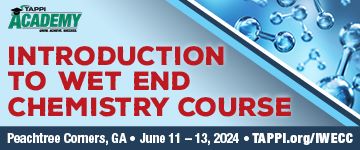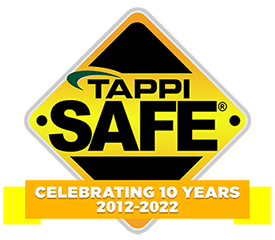 Search
Search
Use the search bar or filters below to find any TAPPI product or publication.
Filters
Content Type
Publications
Level of Knowledge
Committees
Collections
Journal articles

Image analytical monitoring of paper quality - a feasibility
Image analytical monitoring of paper quality - a feasibility study, TAPPI JOURNAL, November 2006
Journal articles

Magazine articles

Effects of tissue additives on copy paper forming and properties, TAPPI Journal February 2024
ABSTRACT: Laboratory tests were conducted in an effort to determine the effects on paper machine process attributes and the properties of paper made from recycled copy paper furnish upon the addition of chemical agents that are commonly used in the production of hygiene tissue products. Due to continuing growth in tissue and towel grades of paper, such agents are experiencing greater usage. Charge titration test results revealed that certain dry strength agents associated with tissue manufacturing have the potential to shift the balance of charge in papermaking furnish to less negative or even positive values. Creping adhesive was found to contribute to fine particle retention, especially when present at relatively high levels. Release aid and a polyacrylate dispersant had the opposite effect. Low addition levels of both a creping adhesive and a debonding agent surprisingly increased a wide range of strength attributes of paper handsheets in comparison to sheets prepared from unaltered recycled copy paper furnish. The debonding agent decreased paper strength at higher levels of addition. Such effects appear to depend not only on the expected effects of agents themselves, but also on how they affect the charge balance of the wet-end system.
Journal articles

Magazine articles

Quantification of hardwood black liquor contamination in pine black liquor, TAPPI Journal February 2024
ABSTRACT: The presence of hardwood black liquor contamination in pine black liquor can negatively impact brownstock washer and evaporator operation, as well as reduce soap separation and yield. It is also believed to negatively impact commercial kraft lignin production. It was desired to develop a method of quantitatively determining the amount of low-level hardwood liquor contamination in pine black liquor. A method employing pyrolysis-gas chromatography mass spectrometry (py-GCMS) was developed to perform the desired measurement. Laboratory cooks with carefully controlled blends of pine and hardwood chips were prepared, and the resulting liquor was measured using this technique. Additionally, samples of pine and hardwood black liquors were blended in known quantities and analyzed. All these samples were submitted as blind samples. The resulting analysis suggests the py-GCMS method was able to accurately determine the level of hardwood contamination between 1% to 10% hardwood liquor using a low-level calibration curve prepared with coniferyl alcohol and sinapyl alcohol as standards.
Journal articles

Fundamental study on developing wood powder as an additive of paperboard, TAPPI JOURNAL November 2014
Fundamental study on developing wood powder as an additive of paperboard, TAPPI JOURNAL November 2014
Journal articles

Editorial: Advances in Pulp Manufacture: A review of the 2012 PEERS Conference, TAPPI JOURNAL February 2013
Editorial: Advances in Pulp Manufacture: A review of the 2012 PEERS Conference, TAPPI JOURNAL February 2013
Journal articles

Guest Editorial: TAPPI Journal showcases the best of PEERS 2012, TAPPI JOURNAL July 2013
Guest Editorial: TAPPI Journal showcases the best of PEERS 2012, TAPPI JOURNAL July 2013
Journal articles

Decreasing specific energy of thermomechanical pulps from reduction of raw materials variability, TAPPI JOURNAL September 2009
Decreasing specific energy of thermomechanical pulps from reduction of raw materials variability, TAPPI JOURNAL September 2009
Journal articles

Operating Costs Related to Instability in a Pulp and Paper Activated Sludge Treatment System, TAPPI JOURNAL October 2009
Operating Costs Related to Instability in a Pulp and Paper Activated Sludge Treatment System, TAPPI JOURNAL October 2009
Journal articles

Magazine articles

Commercially relevant water vapor barrier properties of high amylose starch acetates: Fact or fiction?, TAPPI Journal September 2021
ABSTRACT: Starches have recently regained attention as ecofriendly barrier materials due to the increased demand for sustainable packaging. They are easily processable by conventional plastics processing equipment and have been utilized for oil and grease barrier applications. While starches have excellent oxygen barrier properties and decent water barrier properties at low relative humidity (RH), they are moisture sensitive, as demonstrated by the deterioration of the barrier properties at higher RH values. Starch esters are chemically modified starches where the hydroxyl group of the starch has been substituted by other moieties such as acetates. This imparts hydrophobicity to starches and has been claimed as a good way of retaining water vapor barrier properties of starches, even at high RH conditions. We studied the water vapor barrier properties of one class of starch esters, i.e., high amylose starch acetates that were assumed to have good water vapor barrier properties. Our investigations found that with a high degree of substitution of hydroxyl groups, the modified starches did indeed show improvements in water vapor response as compared to pure high amylose starch films; however, the barrier properties were orders of magnitude lower than commercially used water vapor barriers like polyethylene. Even though these materials had improved water vapor barrier response, high amylose starch acetates are likely unsuitable as water vapor barriers by themselves, as implied by previous literature studies and patents.
Journal articles

Spectroscopic imaging ellipsometry of wood fiber cell walls: a comparison with confocal microscopy, TAPPI JOURNAL, August 2007
Spectroscopic imaging ellipsometry of wood fiber cell walls: a comparison with confocal microscopy, TAPPI JOURNAL, August 2007






